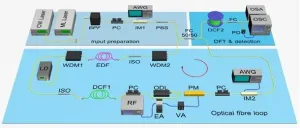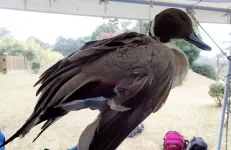Fossilized feeding frenzy
47 million year old fly found with a full belly
2021-03-11
(Press-News.org) It was not the fly itself that caught the scientists' attention, but its bulging abdomen suggesting it was still full with the fly's last food intake. Surprisingly, analysis of the stomach content revealed it was full with pollen from different plants. The fossil pollen from the fly's stomach was used to reconstruct the ancient environment inhabited by the fly, the biotic interactions between plant and fly, and the fly's behaviour during feeding.
Flies as pollinators
Today, bees, butterflies and bumblebees are the typical pollinators, which are also known to feed on pollen. That flies also play an important role in pollination is rarely addressed. "The rich pollen content we discovered in the fly's stomach suggests that flies were already feeding and transporting pollen 47 million years ago and shows it played an important role in the pollen dispersal of several plant taxa", says Fridgeir Grímsson from the Department of Botany and Biodiversity Research of the University of Vienna. "Flies were major pollinators in ancient (sub-)tropical equivalent ecosystems and might even have outshined the bees", the scientist concludes.
Short-distance flights for food
The extracted pollen was dominated by grains of Decodon (waterwillow) and Parthenocissus (virgin ivy). Today, the waterwillow is a sub-shrub growing in wetlands and the shallows of lakes, suggesting open low canopy habitat. The co-dominance of virgin ivy also suggests that the fly fed on plants growing at the forest margin surrounding the ancient Messel lake. "It is likely that the fly avoided long-distance flights between food sources and sought pollen from closely associated plants", says Grímsson.
INFORMATION:
Publication in Current Biology:
S. Wedmann, T. Hörnschemeyer, M.S. Engel, R. Zetter, F. Grímsson. The last meal of an Eocene pollen-feeding fly. Current Biology (2021)
DOI: 10.1016/j.cub.2021.02.025
[Attachments] See images for this press release:

ELSE PRESS RELEASES FROM THIS DATE:
2021-03-11
BOs describe the periodic movement of electrons in solids to which an external static electric field is applied. However, it is challenging to measure the BOs directly in natural solids since the relaxation time of electrons is usually much shorter than the oscillation period. To date, analogies of electron BOs have been extended to the synthetic dimensions of time, frequency and angular momenta. In previous studies, the frequency BOs have been experimentally demonstrated in a nonlinear fibre with cross-phase modulation. However, the frequency spectrum has ...
2021-03-11
An innovative analysis of two-dimensional (2D) materials from engineers at the University of Surrey could boost the development of next-generation solar cells and LEDs.
Three-dimensional perovskites have proved themselves remarkably successful materials for LED devices and solar panels in the past decade. One key issue with these materials, however, is their stability, with device performance decreasing quicker than other state-of-the-art materials. The engineering community believes the 2D variant of perovskites could provide answers to these performance issues.
In a study published in The Journal of Physical Chemistry Letters, researchers from Surrey's Advanced Technology Institute (ATI) detail how to improve the physical properties of 2D perovskite called Ruddlesden-Popper.
The study ...
2021-03-11
Recently, a research group led by Prof. WAN Yinhua from the Institute of Process Engineering (IPE) of the Chinese Academy of Sciences developed a novel targeted modification strategy to improve the separation selectivity of polyamide NF membranes.
The study was published in Journal of Membrane Science on March 10.
The low selectivity of commercial nanofiltration (NF) membranes to monosaccharides and monovalent salts is mainly due to the nonuniform pore size distribution and strong electronegativity.
Targeted modification can regulate the pore size distribution and electronegativity of polyamide NF membranes, and thus improve the separation selectivity.
In the strategy, carboxyl groups (-COOH) on the surface are activated by N-(3-Dimethylaminopropyl)-N'-ethyl ...
2021-03-11
An international collaboration headed by researchers from iPSYCH has found genetic variants that increase the risk of aggression in children with ADHD. In the same study, the researchers also discovered that the genetics which increase aggression in some children with ADHD, are the same genetics that affect aggression in children without a diagnosis.
For the first time, researchers have found positions in the genome that increase the risk of getting ADHD with disruptive behaviour disorders (DBDs). DBDs are child psychiatric disorders characterised by antisocial and ...
2021-03-11
Most new achievements in artificial intelligence (AI) require very large neural networks. They consist of hundreds of millions of neurons arranged in several hundred layers, i.e. they have very "deep" network structures. These large, deep neural networks consume a lot of energy in the computer. Those neural networks that are used in image classification (e.g. face and object recognition) are particularly energy-intensive, since they have to send very many numerical values from one neuron layer to the next with great accuracy in each time cycle.
Computer scientist Wolfgang Maass, together with his PhD student Christoph Stöckl, has ...
2021-03-11
The genetics of human eye colour is much more complex than previously thought, according to a new study published today.
An international team of researchers led by King's College London and Erasmus University Medical Center Rotterdam have identified 50 new genes for eye colour in the largest genetic study of its kind to date. The study, published today in Science Advances, involved the genetic analysis of almost 195,000 people across Europe and Asia.
These findings will help to improve the understanding of eye diseases such as pigmentary glaucoma and ocular albinism, where eye pigment levels play a role.
In addition, the team found ...
2021-03-11
Extremely preterm infants can suffer from a life-threatening inflammation of the gut. A new clinical study has shown that supplements of a lactic acid bacterium may have positive effects by increasing the diversity of intestinal bacteria in these infants. The study has been led by researchers at Linköping University, Sweden, and published in the scientific journal Cell Reports Medicine.
A litre of milk weighs a kilogram. Most infants who are born extremely prematurely weigh less than that. An infant who should have developed and grown for three more months in the protective environment of the mother's womb is, of course, extremely vulnerable. As a consequence of advances in neonatal care, many premature infants survive, although one out of four of the extremely ...
2021-03-11
Robots solving computer games, recognizing human voices, or helping in finding optimal medical treatments: those are only a few astonishing examples of what the field of artificial intelligence has produced in the past years. The ongoing race for better machines has led to the question of how and with what means improvements can be achieved. In parallel, huge recent progress in quantum technologies have confirmed the power of quantum physics, not only for its often peculiar and puzzling theories, but also for real-life applications. Hence, the idea of merging the two fields: on one hand, artificial intelligence ...
2021-03-11
Scientists have discovered a route of introduction for High Pathogenicity Avian Influenza Virus (HPAIV) H5N8 into Japan and, in parallel, have investigated the potential of two human anti-influenza drugs for the control of HPAI in birds.
Since October 30, 2020, there have been over 30 recorded outbreaks of High Pathogenicity Avian Influenza (HPAI) in domestic poultry and wild fowl in Japan. This outbreak was caused by the influenza A virus H5N8, a known High Pathogenicity Avian Influenza Virus (HPAIV). In such a scenario, identification of the source of the virus and its transmission route is important to control its spread.
A team of scientists led by Professor Yoshihiro Sakoda of Hokkaido University have recently found the probable route of introduction of ...
2021-03-11
WASHINGTON -- Researchers have developed a noninvasive technique that can capture images of rod and cone photoreceptors with unprecedented detail. The advance could lead to new treatments and earlier detection for retinal diseases such as macular degeneration, a leading cause of vision loss.
"We are hopeful that this technique will better reveal subtle changes in the size, shape and distribution of rod and cone photoreceptors in diseases that affect the retina," said research team leader Johnny Tam from the National Eye Institute. "Figuring out what happens to these cells before they are lost is an important step toward developing earlier interventions to treat and prevent blindness."
In Optica, The Optical Society's (OSA) journal for high impact research, the researchers show that ...
LAST 30 PRESS RELEASES:
[Press-News.org] Fossilized feeding frenzy
47 million year old fly found with a full belly





